
How Native American Chief Kondiaronk Shaped More Than North America
Kondiaronk was a legendary Native American Chief of the Wendat people in New France who faced the challenge of leading his people in the face of war and destruction. Through his leadership and determination, Kondiaronk not only secured the preservation of his people but also played a key role in shaping the future of the North American continent.
He has also been credited by some as the inspiration for the Enlightenment movement. This article will delve into the life and legacy of this remarkable Native American leader, and explore whether he had any effect he had on the Enlightenment. Join us as we uncover the incredible story of Kondiaronk, the Native American Chief who left an indelible mark on history.
Kondiaronk: The Legendary Chief of the Wendat People
Kondiaronk, aka Le Rat, was a Native American chief of the Huron-Wendat people of Michilimackinac in New France in the late 17th to early 18th century. He was famous for his oratory skills and strategic thinking and led the pro-French Petun and Huron-Wendat refugees of Michilimackinac against their Iroquois enemies.
- Hochelaga, Montreal: Was It A Myth Or Did Cartier Really Discover The Now Lost Village?
- Four Native American Kings Visited Queen Anne in London With a Special Request
The Huron-Wendat were a Native American people who lived in the Great Lakes of America in the 17th century, known for their strong alliance with the French during this time (largely thanks to Kondiaronk). Meanwhile, the Iroquois were the traditional enemies of the Huron-Wendat, a Native American Confederacy of five tribes in the northeastern United States. While the Huron-Wendat were willing to work with the Europeans, the Iroquois were known for their resistance to European expansion in the 17th and 18th centuries.
Today Kondiaronk is best remembered for his role in the Great Peace of Montreal in 1701. This ended the Beaver Wars which was a series of conflicts in the 17th century between the Iroquois Confederacy and the French with their Native American allies (the Huron-Wendat).
The two sides were fighting over control of the fur trade and the territories in the Great Lakes region. With the end of the Beaver Wars, peace was forged between Canada’s native people, while the French and opened up North America’s interior to deeper French exploration and trade. He is considered a Person of National Historic Significance by the Canadian government.
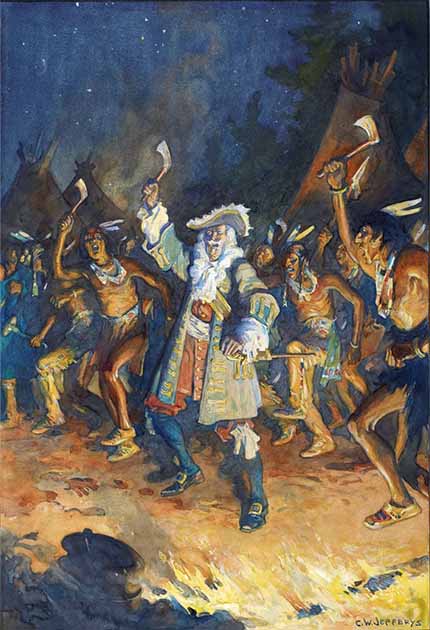
Painting by Charles William Jefferys depicting Frontenac the French governor of New France in North America, alongside Native Americans. (Public domain)
Kondiaronk’s Early Career Navigating Inter-Tribal Relations
Kondiaronk first rose to prominence in 1682 when he represented his Mackinac Huron tribe in negotiations between the French governor, Frontenac, and the Ottawa tribe which shared his village. While we tend to think of native peoples and colonists as having an antagonistic relationship, Kondiaronk was looking for French protection.
An Iroquois chief had been murdered while being held prisoner in Kondiaronk’s village and he feared that the Iroquois tribes would seek revenge. Kondiaronk’s Huron tribe had sent the Iroquois wampum belts to appease the murder. The problem was that the Huron had not sent any wampum belts made by the Ottawa tribe.
The Ottawa tribe felt they were being hung out to dry by the Huron. They told Frontenac that the Huron had put all the blame for the murder on them and then failed to send any Ottawa belts, meaning the Iroquois would still blame them, not the Huron. The Huron, however, claimed they were just trying to keep the peace and had no intention of throwing their neighbors under the bus. French attempts to conciliate the two tribes failed, although Kondiaronk’s plea to the French did secure an alliance that kept both tribes safe from the Iroquois.
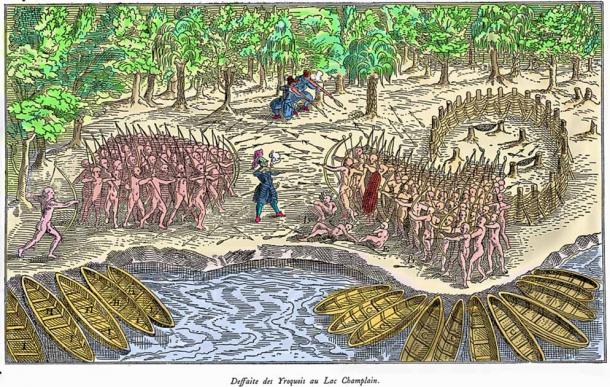
The era was marked by Inter-Tribal warfare. Image shows an event in 1609 when Algonquin, Huron and French forces attacked the Iroqouis in New York. (Public domain)
Kondiaronk the Master Manipulator: The 1688 Coup
Kondiaronk was not just a diplomat. He was a skilled and ruthless tactician who wasn’t afraid of getting his hands dirty. In 1682 he had been successful in getting his tribe French protection, but he knew the best way to keep receiving that protection was to pit the French against his Iroquois enemies.
By 1687 the French, led by Governor-General Denonville, had claimed the lands normally held by the Seneca tribes (the Iroquois). While Europeans claiming great chunks of native land wasn’t a good thing, Kondiaronk tried to make the best of a bad situation. He agreed to ally his tribe with the French as long as Denonville agreed to continue fighting the Iroquois until they were utterly decimated.
Unfortunately, it soon turned out the French couldn’t be trusted. In 1688 Kondiaronk led a war party and set out to raid Iroquois villages. One of his first stops was at Fort Frontenac, a French encampment. While there Kondiaronk discovered that Denonville was in peace talks with the Iroquois, effectively betraying Kondiaronk’s trust.
Kondiaronk withdrew his men back across Lake Ontario and set up an ambush in the surrounding forest. As the Iroquois Onondaga peace delegation passed through on their way to meet Denonville in Montreal, Kondiaronk launched his attack. His men killed one chief and managed to take the remainder of the delegation hostage.
This is where Kondiaronk’s genius showed. The hostages pleaded for their lives, telling him they were a peace delegation and not a war party. Kondiaronk pretended to be surprised and then angry at Denonville’s duplicity. He blamed Denonville for the attack and released the captives, instructing them to tell their chiefs that the French had betrayed both sides.
Kondiaronk then returned home with his party and one Iroquois captive, who had been given as a replacement for one of the Huron warriors killed in the ambush. Kondiaronk presented this captive to the French commandant at Michilimackinac. The French soldier ordered the captive to be killed (he had no idea his government was in peace negotiations with the Iroquois).
Kondiaronk made sure that an old Seneca slave (the Seneca were one of the five tribes that made up the Iroquois) watched the execution. He then sent the slave back to his people. Once there the slave reported back to his countrymen how a Frenchman had had the defenseless captive killed. The Iroquois were outraged at how their brother had been treated by the French and brought peace negotiations to a halt. All thanks to Kondiaronk’s masterful manipulation.
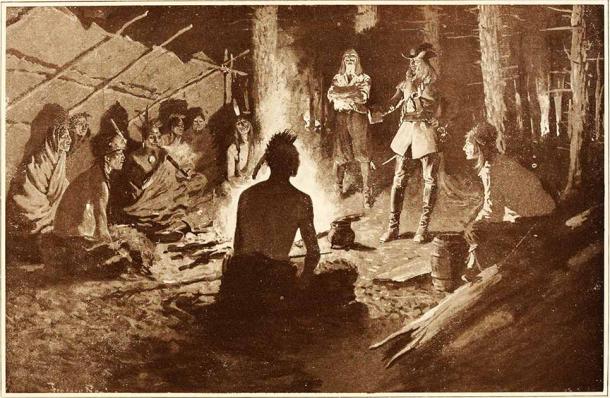
Talks at an Iroquois council fire. (Public domain)
The Ramifications of Kondiaronk's Machinations
From 1689 onwards, a decade-long conflict known as Frontenac's War ravaged the region. This involved a series of conflicts between the French and their old enemies, the English. Thanks to Kondiaronk’s earlier manipulation this included battles between the French and the Iroquois, who had gained the support of the English.
This isn’t to say everything went Kondiaronk’s way. The French were not naive and deemed Kondiaronk responsible for enraging the Iroquois to an extent where it had become impracticable for the French to negotiate with them. As a result of Kondiaronk's manipulations, the summer of 1689 saw the massacre at Lachine, where 1,500 Iroquois warriors launched a sudden assault on the small French colony. The attackers burned and looted French plantations, killing their settlers.
Kondiaronk’s reputation took another beating in 1689 when he was caught plotting with the Iroquois for the destruction of their Ottawa neighbors. It was becoming clear that Kondiaronk could only play both sides for so long.
By 1697 Kondiaronk’s tribe was split into two different factions, the pro-French led by Kondiaronk and a pro-Iroquois faction. That year Kondiaronk made it clear which side he was on by warning the Miamis (another native tribe) of an imminent Iroquois attack. Kondiaronk and 150 of his men fought a two-hour canoe battle on Lake Erie, defeating a party of 60 Iroquois. Kondiaronk’s standing with the French was firmly re-established.
In 1697 the war began to wind down and a period of intense diplomatic activity began. It was during this activity that Kondiaronk secured the reputation he is known for today. It all began with the Treaty of Ryswick of 1697 which brought conflict in Europe to an end and with which New York and New France agreed to stop fighting.
The treaty prompted New York to urge New France to reconcile with the Iroquois. Having lost the support of English military, the Iroquois recognized their inability to withstand New France if the conflict persisted. By September of 1700 they had consented to a peace agreement,
With peace settled between the French and Iroquois, Kondiaronk knew only one thing was left. The different Indian nations needed to bring an end to their war and stop the fighting. He returned home to Michilimackinac and urged all the Indian nations to follow him the following August. In doing so he became the architect of the peace agreement of 1701.
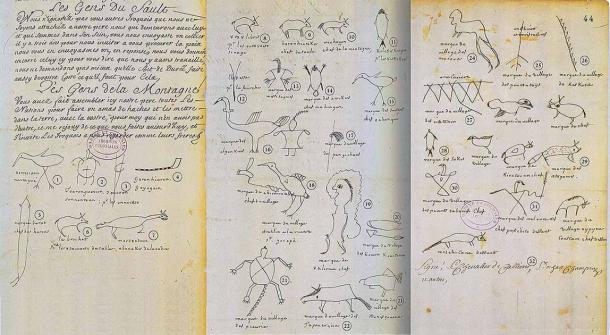
Copy of the Great Peace of Montreal including signatures. (Public domain)
Kondiaronk’s Enduring Legacy: The Last Push for Inter-Tribal Peace
The final Indian Congress began on 21 July 1701. The aim was simple, to stop all the fighting between the different tribes and to ensure peace between the natives and the French. Although all parties sought to achieve peace, one obstacle remained: the repatriation of countless prisoners who had been captured or enslaved during the long-standing conflicts and raids.
By the 25th of July, peace talks were well underway and things looked promising. That day Kondiaronk spoke at length about how in his experience recovering Iroquois prisoners was a difficult process. He was unconvinced that after 13 years of war, his allies could trust the Iroquois to return their prisoners.
Nevertheless, amidst the overwhelming desire for reconciliation, all the different tribes left their Iroquois prisoners with the Iroquois that very night as a gesture of goodwill. Despite this, Kondiaronk remained unconvinced and apprehensive that his comrades had been deceived.
The subsequent day proved Kondiaronk’s suspicions correct when the Iroquois acknowledged that they were unable to return all the prisoners they had pledged to repatriate. The Iroquois asserted that all the children they had taken over the years had been given to families for adoption and could not be returned to their native tribes.
The various tribes taking part in the process were outraged. They had purposely separated their young captives from their foster families to return them in the lead-up to the peace summit. With the talks teetering on the brink of collapse, heated debates ensued, particularly affecting Kondiaronk who was deeply disheartened. He had urged his allies to bring their prisoners, only to see the Iroquois thwart his efforts towards a peaceful exchange.
Towards the end of the peace negotiations, Kondiaronk fell seriously ill. On August 1st, he was unable to stand and participated in the day’s proceedings from a seated position. Despite his frailty, he spent the day reproaching the Iroquois for their actions and highlighting his role in preventing further conflict.
On his final day, Kondiaronk delivered stirring speeches on the imperative need for the tribes to unite and end their hostilities. His words proved persuasive and ultimately convinced the tribes to sign the Great Peace. Sadly, Kondiaronk never witnessed the signing, as he passed away at 2 am the following day at the age of 52.
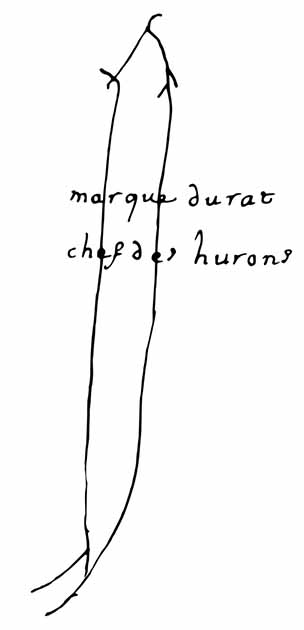
Kondiaronk’s signature on the Great Peace of Montreal in representation of the Huron-Wyandot. (Public domain)
Parallels Between Kondiaronk and the Enlightenment
So, what does all this have to do with the Enlightenment? An 18th century intellectual movement that happened long after the great Chief’s death and on the other side of the planet. According to some historians, Kondiaronk’s actions, particularly his success in negotiating the Great Peace, may have had an impact.
The Enlightenment was characterized by a focus on reason, science and individualism, as well as a rejection of traditional institutions and beliefs. Followers of the Enlightenment believed in the power of human reason’s ability to understand the world and effect significant change by improving society. They also emphasized the importance of freedom, tolerance and equality.
Kondiaronk’s contribution to negotiating the Great Peace aligns with these values. The treaty that secured peace between the French and Iroquois Confederacy and safeguarded the Huron-Wendat people’s existence was based on diplomacy, recognition of different nations’ rights, and a rejection of the concept of war of conquest. These values are consistent with those of the Enlightenment era.
· The True Story of Pocahontas as NOT told by Disney
The treaty laid out a plan for lasting peace, the recognition of the rights of different nations, and the importance of diplomacy. All things that line up with Enlightenment values. Furthermore, the treaty demonstrated that peaceful coexistence between different peoples, which was an important idea in the Enlightenment, was possible. The treaty rejected the idea that one culture or nation was superior to others and that war was the only solution to conflicts between nations.
Enlightenment also valued individualism, something Kondiaronk can also be seen as representing. He was an individual who made a major difference in the history of his people as well as his nation. Kondiaronk was not bound by traditional institutions or beliefs but instead relied on his own reason, intelligence, and intuition to achieve lasting peace. He exemplifies how individuals are able to change the world for the better.
His actions also align him with the Enlightenment’s emphasis on the importance of both education and knowledge. Kondiaronk is remembered for his intelligence and ability to navigate a complex political landscape, playing all sides at once. A skilled diplomat and negotiator, his achievements were a direct result of his knowledge and wisdom.
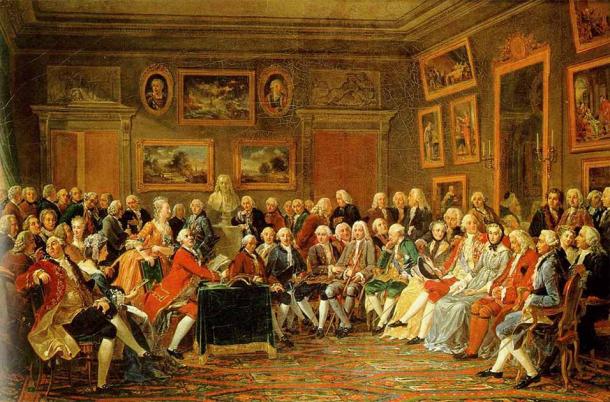
Reading of Voltaire's tragedy of the Orphan of China in the salon of Marie Thérèse Rodet Geoffrin in 1755, by Anicet Charles Gabriel Lemonnier, circa 1812. (Public domain)
The Impact of Indigenous Philosophy on European Colonists
Two of the biggest proponents of the idea that Kondriaronk affected the Enlightenment are David Graeber and David Wengrow, the authors of The Dawn of Everything. In this book, the two write about how during the late 1600s European colonists in North America spent a lot of time engaging in philosophical discussions with the indigenous peoples. Many of their discussions with Kondiaronk were recorded.
Kondiaronk was scathing of European social customs and values. He hated monarchical rule, social hierarchies and Europe’s love of wealth and materialism as well as its punitive justice systems. In their book, the two historians argue that these discussions made their way back to Europe and were distributed amongst the intellectual class inspiring the Enlightenment.
This isn’t to say everyone agrees with this viewpoint. Some historians are dubious as to whether Kondiaronk said half the things he is reported as having said. They point out that historians of the time had a habit of “embellishing” to reinforce their own views.
There’s also the fact that historically speaking, Europeans tended to be pretty dismissive of what indigenous peoples said or believed. The idea that Europeans would not only have been receptive to an indigenous person's critique, but used it to shape an entire intellectual movement is nice but seems sadly unlikely.
Kondiaronk’s efforts in creating peace and his reputation as a great orator and brilliant strategist can be seen as an example of the Enlightenment’s views. Kondiaronk oozed rationality, diplomacy and individuality, but it is debatable whether his actions or words had a direct impact on the Enlightenment movement.
Top image: Postage stamp depicting the Great Peace of Montreal. Source: konstantant / Adobe Stock
References
Graeber. D & Wengrow. D. 2021. The Dawn of Everything. Farrar, Straus and Giroux.
Fenton. W. 1969. “KONDIARONK” in Dictionary of Canadian History. Available at: http://www.biographi.ca/en/bio/kondiaronk_2E.html
Noakes. T. 2014. “Kondiaronk” in The Canadian Encyclopaedia. Available at: https://www.thecanadianencyclopedia.ca/en/article/kondiaronk
Baird. C. 2021. “Kondiaronk” in Canadian history Ehx. Available at: https://canadaehx.com/2021/04/17/kondiaronk/
















Comments
Actually, Lahontan did not attribute those Enlightenment ideas to Kondiaronk. Those ideas are in a supposed dialog between Lahontan and Adario, and Graeber and Wengrow claim that Adario is based on Kondiaronk.
Lahontan in the dialog clearly represents the views of the typical Frenchman, not Lahontan’s own views. Adario may be based on Kondiaronk, but his views clearly are not just transcriptions of what Kondiaronk said. Eg, his views on religion represent the Enlightenment “Religion of Reason” and leave out the Huron’s animism – which Kondiaronk clearly would have mentioned in such a long discussion of religion.
To read the dialogs, see the second volume of Lahontan’s New Voyages to North America.
Question is, did the French propaganda of those times create the role for and legend of him?
Nobody gets paid to tell the truth.